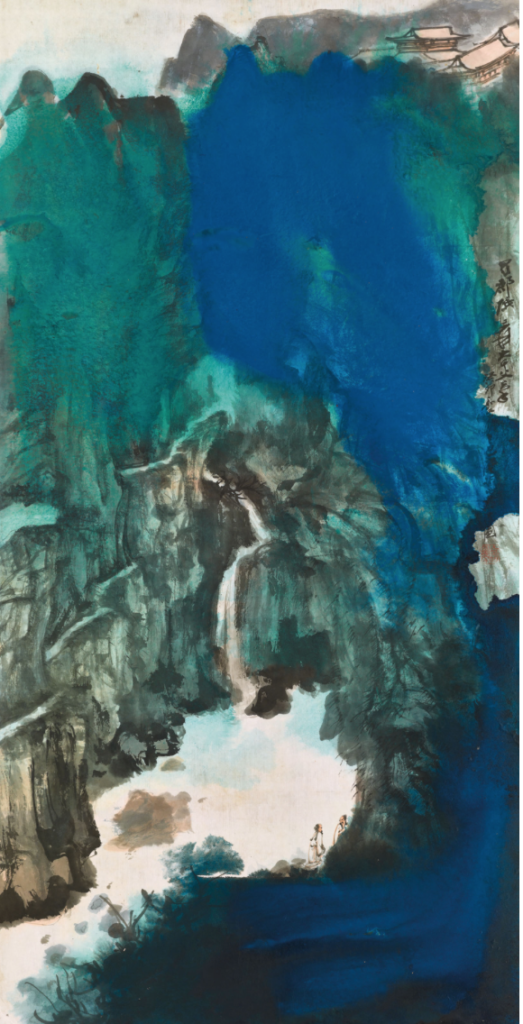ZHANG DAQIAN (1899-1983)
Viewing the Waterfall
Scroll, mounted on wooden board and framed, ink and colour on paper
134 x 68 cm. (52 ¾ x 26 ¾ in.)
Inscribed and signed, with one seal of the artist
Dated twelfth month, guimao year (1963)
PROVENANCE: Christie’s Hong Kong, Fine Modern and Contemporary Chinese Paintings, 25 April 2004, Lot 41;
Previously from the Collection of Chai Sian Kwan
EXHIBITION HISTORY: San Francisco, Center of Asian Art and Culture, Chang Dai-chien, A Retrospective, 16 November – 17 December 1972.
Taipei, National Museum of History, The Anniversary Exhibition of Chang Dai-chien’s 90th Birthday, June 1988.
Hong Kong, Sun Museum, Dawn of a Sunny Century: 20th-Century Chinese Paintings from the Yitao Collection, 16 May – 17 October, 2015.
Price Realised: HKD 64,225,000 Estimate: HKD 60,000,000 – HKD 80,000,000 Auction Closed: 28 May 2018

Zhang Daqian, artist and painter was originally born in Neijiang, China on May 10, 1899. Daqian grew to become one of the most remarkable and virtuous of traditional Chinese Masters in his time. Zhang Daqian derived his mastery of aptitude and artistic license from his family, specifically his mother and eldest brother, Zhang Shanzi. Both Shanzi and Daqian voyaged around inseparably to learn the art of textile painting during. The early twentieth century the two brother ventured to Kyoto, Japan to learn this craft. While Shanzi focused on producing animals in art, Daqian concentrated more on landscapes, seascapes, and pastorals in nature and its beauty in his oeuvre. Daqian was considered at the time a creator of Guohua compositions of traditional Chinese art. However, in the early 1900s Daqian’s techniques shifted dramatically and stylistically became more impressionist. He was heavily galvanized and impacted by artists such as Shitao (1642-1707) as well as Nada Shanren (1626-1705). In many of Zhang Daqian’s masterpieces from the 1960s onward, we as an audience see a prolific explosiveness in colors consisting of cerulean, jade and Prussian blue which conquer the composition. Zhang Daqian attracts the naked eye encompassed in a wide variety of audiences-artists, intellectuals, art historians, and people of the common herd.
In the elongated scroll painting, Viewing the Waterfall, 1963, we as an audience are immediately drawn towards the equidistant brilliant blue portion of this opus. Daqian, upon utilizing inks of various shades of blues and greens, incorporates the colors in such a way that when looking at the painting you feel as though your soul is filled just as the water is filling the deeper bank below in the right hand corner. There is such a profoundness to this piece that it leaves you feeling swept with an abundance of nirvana and pure bliss. While the water rushes down and the ink seeps into the scroll, we as an audience question whether this work of water was spilling in a violent or serene matter despite its calming depiction. Towards the end of the water, we are ever so subtly struck by two figures of poetic and philosophic intellect. We can assume they are intellectuals due to their crisp vestments and engaging polite conversation that is ongoing. The two men in a way resemble kindred spirits admiring the nature while appearing to be quite almost literally “in the middle of nowhere.” This idea and placement of kindred spirits was a nineteenth century Romantic convention and is specifically reminiscent of the German painter, Caspar David Friedrich’s works featuring kindred spirits in solitude adoring nature and what it has to offer. The philosophers depicted by Daqian are like wanderers in a sea of mist. There is so much life in this work. Not only is there life in nature’s lush and fertile femininity of water rhythmically running, but there is also civilization as seen with the two scholars and the temple which rests up above the precipice of the mountain. The temple is mysterious as it so peacefully sits up in what seems to be “the heavens.” With the placement of the waterfall, two academics and temple, Daqian situates the viewer to immerse themselves in the inner most part of the painting being the cosmos. As an audience we are stupefied by these magnetic shades of blue as we feel at ease, and comfortably pleasant in the present moment in the terrestrial realm.
By: Isabella Di Scipio